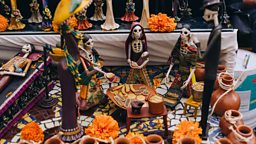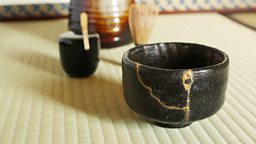How ancient wisdom from other cultures can improve your life
In his illuminating Βι¶ΉΤΌΕΔ Radio 4 podcast Something to Declare, podcaster Jack Boswell explores how ancient wisdom from around the world can help us understand and maybe even improve our own lives.
Jack explores the roots of global cultural practices and timeless knowledge through conversation and connection with people from all across the globe, offering a fresh approach to coping with the big and small nuances and challenges of everyday life.
-
![]()
Something to Declare
Something to Declare: Lessons to help us understand and maybe even improve our lives.
Jack explores questions like: how can the art of reading unspoken social cues help us to foster connection? What can a South African philosophy teach us about how to nurture our communities? And how can a Portuguese genre of music help us to express our emotions and make peace with the past?
Here are three inspiring things we learnt from the first few episodes.

1. How to celebrate life after death
Most of us aren’t very good at talking about death. Grief can feel too hard to bear, and discussing it can bring up uncomfortable feelings about our own inevitable demise. What if there was a way to break that taboo?
You’re celebrating the dead but it’s really a celebration of life – the life of the dead.Carlos Alberto Sanchez, San José State University
Well in Mexico, they actually celebrate death. On Día de los Muertos, or “Day of the Dead”, families honour their deceased loved ones and invite their spirits back to visit. They do this by creating an “ofrenda” (altar), decorated with the things that person loved in life: their favourite tequila, maybe, or food or a book.
“Día de los Muertos is a festival that celebrates the life of those that have already passed but at the same time invites them to rejoin life for a moment,” explains Carlos Alberto Sanchez, a Mexican philosophy professor at San José State University. “Yes, you’re celebrating the dead but it’s really a celebration of life – the life of the dead – to build community, to build family history, to build connection.”
Cemeteries brim with colours and smells. “It’s this very vibrant and fragrant occasion,” says Carlos, that contrasts with the sombre approach to death taken in the West. And death isn’t feared as something in the future, like it is in Western culture, but seen as being of the past and of the present. “This notion of death makes it so that people are not afraid of it, because it’s already all around you.”
The Day of the Dead Festival in London is now hugely popular – proving that buttoned-up Brits can be open to the idea of celebrating death. Its director, Paola Feregrino, says having an outlet to remember loved ones is why it's catching on. Grief can be paralysing, but the act of thinking about how we want to entice our relatives back can help channel it into something proactive.
“It’s an opportunity for us to talk about them,” says Paola. “Truly remembering your loved ones within yourself, your soul, your heart, your head – I think that is a really powerful thing.”

2. How to embrace imperfection
Do you have trouble letting go of negative or uncomfortable experiences in your life? Do they keep you up at night?
Wabi Sabi is to recognise that all experiences, even bad ones, can have a positive element.
The Japanese philosophy of Wabi Sabi could help. The main point of Wabi Sabi is to recognise that all experiences, even bad ones, can have a positive element, without completely eradicating the negative, explains Dr Takeshi Morisato, a lecturer in non-Western philosophy at the University of Edinburgh. The trouble with Western philosophy, says Takeshi, is that we watch too many Disney movies. We crave the happy ending. “We have to resist our desire to turn everything into a positive… we have to find the beauty in that negative experience.”
Wabi Sabi is an art of acceptance, that finds beauty in life’s flaws and incompleteness. It’s a welcome counterpoint to the Western pursuit of happiness and perfection, and modern concepts of beauty: “We are not that perfect, we are not that symmetrical, and why don’t we just embrace that reality?” suggests Takeshi.
One practical application is the art of Kintsugi, a Japanese repair technique. “It’s a way of putting a bowl or a piece back together that, rather than making it as good as new, actually accentuates the seams of the break using gold,” explains Bonnie Kemske, a ceramic artist. Kintsugi treats the breakage as a part of the history of the object, rather than something to disguise. “It’s about really appreciating that imperfection and understanding that that imperfection can be beautiful in itself.”
So, Wabi Sabi is about embracing imperfections – both in the world around us and within ourselves. It could help us be more present and accepting, and give us the freedom to see our lives as ever-evolving works in progress.

3. How to build for our future
If we are thinking about the future we want to create for generations to come, we could draw inspiration from the spectacular living root bridges of Meghalaya in North East India.
People are starting bridges that they may never walk across themselves.
These bridges are grown from the aerial roots of a species of plant called Ficus Elastica, cultivated by rural village communities who use them to cross the rivers and deep canyons. “They’re a part of the rainforest, but they’re also a manmade project,” explains Dr Wilfrid Middleton, a researcher in Living Architecture at the Technical University Munich.
The roots are super supple so they can be wound on to a bamboo scaffolding or tied on to other roots where they will graft on. When the roots reach the ground, they get thicker and become a solid basis for the structure of the bridge. Some, moss-covered and spanning huge canyons, are thought to be hundreds of years old. “There’s one really fantastic bridge that is supposedly 400 years old,” says Dr Wilfrid.
Managing the bridges takes daily work, which people do as they are going to work, school or market. “It’s this labour of love,” says Wilfrid. “Having this common project for people to work on I think can really tie a community together.” The knowledge of how to maintain them is passed down from elders to the next generation.
The bridges also help prevent landslides, and are more resilient than those made out of concrete and metal because they adapt to the changing landscape around them. They show there’s a natural alternative to modern building practices. We know the climate is going to change, says Wilfrid. “We should use the knowledge we have to build for something that’s a bit more resilient to that kind of change.”
Typically, the living bridges take 10 to 15 years until they can support the weight of humans; people are starting bridges that they may never walk across themselves. In the West, we should embrace the idea that not every decision we make today is for us – but for those coming in the future.
In an age of rapid construction, the living root bridges of Meghalaya show us that sometimes, the best way forward is to take the long view.
Other episodes available or coming up in Something to Declare:
How to Nurture Community – Jack explores Ubuntu, the South African philosophy of connection and shared humanity.
How to Appreciate What Matters – Jack finds out how Quechua-speaking communities in the Andes mountains of Peru cherish sacred moments in their natural surroundings.
-
![]()
Something To Declare
Jack Boswell explores how ancient wisdom from other cultures can help us understand and maybe even improve our own lives.
-
![]()
Just One Thing - with Michael Mosley
Michael Mosley looks at how a number of simple activities that you can do throughout the day can benefit your health and wellbeing.
-
![]()
Life Changing with Sian Wiliams
Dr Sian Williams talks to people who have lived through extraordinary events that have set their lives on an entirely different course.
-
![]()
This Natural Life
Martha Kearney and guests go to a favourite place to explore their passion for nature




